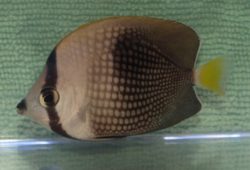The Redtail and Fantail Filefishes in the Tropical Saltwater Tank
The following article is about The Redtail and Fantail Filefishes in the Tropical Saltwater Tank. These two commonly available filefishes make great first filefishes for the tropical marine aquarist looking for a peaceful fish for a fish-only saltwater aquarium.

Of the five genera of filefishes most commonly seen in the hobby, the aquarist considering his or her first filefish is encouraged to look to the genera Pervagor first. There are eight currently described species within the genera. They are:
- P. alternans (yelloweye filefish)
- P. aspricaudus (lacefin filefish, lacefin filefish)
- P. janthinosoma (Blackbar filefish)
- P. marginalis (no English common name)
- P. melanocephalus (redtail filefish)
- P. nigrolineatus (Blacklined filefish)
- P. randalli (no English common name)
- P. spilosoma (fantail filefish, orangetail)
Of these eight species, two species commonly seen in the hobby make great first tilefishes for the beginning tropical marine aquarist. They are the redtail filefish (P. melanocephalus) and the fantail filefish (Pervagor spilosoma).
Contents
Redtail Filefish (Pervagor melanocephalus)
The redtail filefish is a tropical reef-associated marine fish indigenous to the Indo-West Pacific, where it inhabits both coastal reefs and protected outer reefs at depths down to 120 feet. The head of the redtail filefish, also called the blackheaded filefish, can vary in color from black to gray to a dirty blue color. The rest of the body is always a redish-orange color, although the intensity varies based on geography.
Husbandry: Habitat
These are peaceful fish, but should be kept one to a tank unless a pair can be acquired. Expect the redtail filefish to grow to six inches, and, as such, it requires an aquarium of at least 50 gallons with plenty of live rock and other décor in which it can hide and explore. This is a secretive fish both in the wild and in the aquarium. Because the redtail filefish is an opportunistic omnivore, expect it to at least taste any invertebrates in the system (including coral). As such, this fish cannot be considered reef compatible and should therefore be kept in a fish only system.
Husbandry: Diet
Some aquarists have reported difficulty initially weaning the redtail filefish onto a captive diet. Ask to see it feed at the local fish store (you should actually almost always ask to see a potential purchase feed), or ask an online dealer to hold the fish (after you have put down a deposit, of course) until it is feeding well on a captive diet.
Once adjusted, the redtail filefish should readily accept small bits of meaty marine flesh such as raw table shrimp, squid, clams, and scallops. It will also accept freeze-dried and frozen food. Make sure to keep the diet varied by adding an herbivorous food to the mix at least several times a week. Filefishes do best when fed multiple small meals throughout the day as opposed to two larger meals.
Fantail Filefish (Pervagor spilosoma)
The fantail filefish is generally considered an easier fish to keep than the above redtail filefish. Like the redtail filefish, the fantail filefish is a tropical reef-associated marine fish. Unlike the redtail filefish, the fantail filefish is indigenous to the Eastern Pacific and is commonly collected from the Hawaiian Islands, where it inhabits coral reefs and lives amongst coral rubble and sand, sometimes at great depth. The fantail filefish’s head is marked with irregular, oblique dark lines. These lines coalesce with spots on the fish’s body, making for a very distinctive and attractive fish. The caudal fin of the fantail filefish is a reddish-orange, with other fins being a translucent yellow color.
Husbandry: Habitat
Like other members of the genus, the fantail filefish is a peaceful fish, but should still be kept one to a tank unless a pair can be acquired. The fantail filefish may grow to seven inches and requires an aquarium of at least 50 gallons with plenty of live rock and other décor in which it can hide and explore. This is a secretive fish both in the wild and in the aquarium. The fantail filefish is also an opportunistic omnivore and cannot be considered reef compatible.
Husbandry: Diet
The fantail filefish is considered an easier fish to keep largely because it more readily takes to a captive diet. Still, ask to see it feed at the local fish store, or ask an online dealer to hold the fish until it is feeding well on a captive diet. This fish should be fed a diet similar to the redtail filefish. Filefishes do best when fed multiple small meals throughout the day as opposed to two larger meals.



